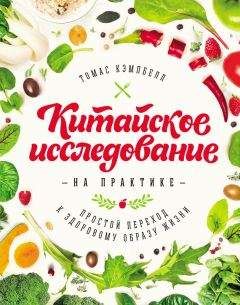208
Bachman J. L., Reedy J., Subar A. F., Krebs-Smith S. M. Sources of food group intakes among the US population, 2001–2002 // Journal of the American Dietetic Association, 2008. Vol. 108. Pp. 804–814.
Sapone A., Bai J. C., Ciacci C. et al. Spectrum of gluten-related disorders: Consensus on new nomenclature and classification // BMC Medicine, 2012. Vol. 10. P. 13.
Boyce J. A., Assa’ad A., Burks A. W. et al. Guidelines for the diagnosis and management of food allergy in the United States: Report of the NIAID-sponsored expert panel. NIH Publication No. 11–7700. Bethesda, MD: National Institutes of Health, December 2010 // www.niaid.nih.gov/topics/foodallergy/clinical/documents/faguidelinesexecsummary.pdf.
Rona R. J., Keil T., Summers C. et al. The prevalence of food allergy: A metaanalysis // Journal of Allergy and Clinical Immunology, 2007. Vol. 120. Pp. 638–646.
Zuidmeer L., Goldhahn K., Rona R. J. et al. The prevalence of plant food allergies: A systematic review // Journal of Allergy and Clinical Immunology, 2008. Vol. 121. Pp. 1210–1218.e4.
Rashtak S., Murray J. A. Celiac disease in the elderly // Gastroenterology Clinics of North America, 2009. Vol. 38. Pp. 433–446.
Fasano A., Berti I., Gerarduzzi T. et al. Prevalence of celiac disease in at-risk and not-at-risk groups in the United States: A large multicenter study // Archives of Internal Medicine, 2003. Vol. 163. Pp. 286–292.
Fasano A., Catassi C. Celiac disease // New England Journal of Medicine, 2012. Vol. 367. Pp. 2419–2426.
Kellogg E. A. Evolutionary history of the grasses // Plant Physiology, 2001. Vol. 125. Pp. 1198–1205.
Karell K., Louka A. S., Moodie S. J. et al. HLA types in celiac disease patients not carrying the DQA1*05-DQB1*02 (DQ2) heterodimer: Results from the European Genetics Cluster on Celiac Disease // Human Immunology, 2003. Vol. 64. Pp. 469–477.
Trynka G., Wijmenga C., van Heel D. A. A genetic perspective on coeliac disease // Trends in Molecular Medicine, 2010. Vol. 16. Pp. 537–550.
Farrell R. J., Kelly C. P. Celiac disease and refractory celiac disease // M. H. Sleisenger, M. Feldman, L. S. Friedman, L. J. Brandt, eds. Sleisenger and Fordtran’s gastrointestinal and liver disease: Pathophysiology, diagnosis, management. 9th ed. Philadelphia: Saunders/Elsevier, 2010.
Simell S., Hoppu S., Hekkala A. et al. Fate of five celiac disease-associated antibodies during normal diet in genetically at-risk children observed from birth in a natural history study // American Journal of Gastroenterology, 2007. Vol. 102. Pp. 2026–2035.
Matysiak-Budnik T., Malamut G., de Serre N. P.-M. et al. Long-term follow-up of 61 coeliac patients diagnosed in childhood: Evolution toward latency is possible on a normal diet // Gut, 2007. Vol. 56. Pp. 1379–1386.
Myléus A., Hernell O., Gothefors L. et al. Early infections are associated with increased risk for celiac disease: An incident case-referent study // BMC Pediatrics, 2012. Vol. 12. P. 194.
Fasano A., Catassi C. Early feeding practices and their impact on development of celiac disease // Nestlé Nutrition Workshop Series: Pediatric Programme, 2011. Vol. 68. Pp. 201–209.
Shamir R. Can feeding practices during infancy change the risk for celiac disease? // Israel Medical Association Journal, 2012. Vol. 14. Pp. 50–52.
DePaolo R. W., Abadie V., Tang F. et al. Co-adjuvant effects of retinoic acid and IL-15 induce inflammatory immunity to dietary antigens // Nature, 2011. Vol. 471. Pp. 220–224.
Brown K., DeCoffe D., Molcan E., Gibson D. L. Diet-induced dysbiosis of the intestinal microbiota and the effects on immunity and disease // Nutrients, 2012. Vol. 4. Pp. 1095–1119.
Salmi T. T., Hervonen K., Kautiainen H. et al. Prevalence and incidence of dermatitis herpetiformis: A 40-year prospective study from Finland // British Journal of Dermatology, 2011. Vol. 165. Pp. 354–359.
Sapone A., Bai J. C., Ciacci C. et al. Spectrum of gluten-related disorders: Consensus on new nomenclature and classification // BMC Medicine, 2012. Vol. 10. P. 13.
Toscano V., Conti F. G., Anastasi E. et al. Importance of gluten in the induction of endocrine autoantibodies and organ dysfunction in adolescent celiac patients // American Journal of Gastroenterology, 2000. Vol. 95. Pp. 1742–1748.
Mahmud F. H., Murray J. A., Kudva Y. C. et al. Celiac disease in type 1 diabetes mellitus in a North American community: Prevalence, serologic screening, and clinical features // Mayo Clinic Proceedings, 2005. Vol. 80. Pp. 1429–1434.
Funda D. P., Kaas A., Bock T. et al. Gluten-free diet prevents diabetes in NOD mice // Diabetes/Metabolism Research and Reviews, 1999. Vol. 15. Pp. 323–327.
Pastore M. R., Bazzigaluppi E., Belloni C. et al. Six months of gluten-free diet do not influence autoantibody titers, but improve insulin secretion in subjects at high risk for type 1 diabetes // Journal of Clinical Endocrinology and Metabolism, 2003. Vol. 88. Pp. 162–165.
Elliott R. B., Reddy S. N., Bibby N. J., Kida K. Dietary prevention of diabetes in the nonobese diabetic mouse // Diabetologia, 1988. Vol. 31. Pp. 62–64.
van Belle T. L., Coppieters K. T., von Herrath M. G. Type 1 diabetes: Etiology, immunology, and therapeutic strategies // Physiological Reviews, 2011. Vol. 91. Pp. 79–118.
Knip M., Virtanen S. M., Sepp. K. et al. Dietary intervention in infancy and later signs of beta-cell autoimmunity // New England Journal of Medicine, 2010. Vol. 363. Pp. 1900–1908.
Carroccio A., Mansueto P., Iacono G. et al. Non-celiac wheat sensitivity diagnosed by double-blind placebo-controlled challenge: Exploring a new clinical entity // American Journal of Gastroenterology, 2012. Vol. 107. Pp. 1898–1906.
Biesiekierski J. R., Newnham E. D., Irving P. M. et al. Gluten causes gastrointestinal symptoms in subjects without celiac disease: A double-blind randomized placebo-controlled trial // American Journal of Gastroenterology, 2011. Vol. 106. Pp. 508–514.
Lundin K. E., Alaedini A. Non-celiac gluten sensitivity // Gastrointestinal Endoscopy Clinics of North America, 2012. Vol. 22. Pp. 723–734.
Sverker A., Hensing G., Hallert C. “Controlled by food” — Lived experiences of coeliac disease // Journal of Human Nutrition and Dietetics, 2005. Vol. 18. Pp. 171–180.
Riddle J., McEvoy M. What are the basic requirements for organic certification? Washington State Department of Agriculture, December 20, 2006 // agr.wa.gov/foodanimal/organic/Certificate/2006/OrganicRequirementsSimplified.pdf.
Heaton S. Organic farming, food quality and human health. Bristol, UK: Soil Association, 2001.
Magkos F., Arvaniti F., Zampelas A. Organic food: Buying more safety or just peace of mind? A critical review of the literature // Critical Reviews in Food Science and Nutrition, 2006. Vol. 46. Pp. 23–56.
Worthington V. Nutritional quality of organic versus conventional fruits, vegetables, and grains // Journal of Alternative and Complementary Medicine, 2001. Vol. 7. Pp. 161–173.
Magkos F., Arvaniti F., Zampelas A. Organic food: Nutritious food or food for thought? A review of the evidence // International Journal of Food Sciences and Nutrition, 2003. Vol. 54. Pp. 357–371.
Benbrook C., Zhao X., Yanez J. et al. New evidence confirms the nutritional superiority of plant-based organic foods. Washington, DC: Organic Center, 2008.
Dangour A. D., Dodhia S. K., Hayter A. et al. Nutritional quality of organic foods: A systematic review // American Journal of Clinical Nutrition, 2009. Vol. 90. Pp. 680–685.
Smith-Spangler C., Brandeau M. L., Hunter G. E. et al. Are organic foods safer or healthier than conventional alternatives? A systematic review // Annals of Internal Medicine, 2012. Vol. 157. Pp. 348–366.
Daley C. A., Abbott A., Doyle P. S. et al. A review of fatty acid profiles and antioxidant content in grass-fed and grain-fed beef // Nutrition Journal, 2010. Vol. 9. P. 10.
Baker B. P., Benbrook C. M., Groth E. 3rd, Lutz Benbrook K. Pesticide residues in conventional, integrated pest management (IPM)-grown and organic foods: Insights from three US data sets // Food Additives and Contaminants, 2002. Vol. 19. Pp. 427–446.
Lu C., Barr D. B., Pearson M. A., Waller L. A. Dietary intake and its contribution to longitudinal organophosphorus pesticide exposure in urban/suburban children // Environmental Health Perspectives, 2008. Vol. 116. Pp. 537–542.
Lu C., Toepel K., Irish R. et al. Organic diets significantly lower children’s dietary exposure to organophosphorus pesticides // Environmental Health Perspectives, 2006. Vol. 114. Pp. 260–263.
Calvert G. M., Karnik J., Mehler L. et al. Acute pesticide poisoning among agricultural workers in the United States, 1998–2005 // American Journal of Industrial Medicine, 2008. Vol. 51. Pp. 883–898.
Blair A., Freeman L. B. Epidemiologic studies in agricultural populations: Observations and future directions // Journal of Agromedicine, 2009. Vol. 14. Pp. 125–131.
Infante-Rivard C., Weichenthal S. Pesticides and childhood cancer: An update of Zahm and Ward’s 1998 review // Journal of Toxicology and Environmental Health: Part B, Critical Reviews, 2007. Vol. 10. Pp. 81–99.
Vinson F., Merhi M., Baldi I. et al. Exposure to pesticides and risk of childhood cancer: A meta-analysis of recent epidemiological studies // Occupational and Environmental Medicine, 2011. Vol. 68. Pp. 694–702.
American Academy of Pediatrics. Policy statement: Pesticide exposure in children // Pediatrics, 2012. Vol. 130. Pp. e1757–e1763.
Dangour A. D., Lock K., Hayter A. et al. Nutrition-related health effects of organic foods: A systematic review // American Journal of Clinical Nutrition, 2010. Vol. 92. Pp. 203–210.
Кэмпбелл К., Кэмпбелл Т. Китайское исследование. Результаты самого масштабного исследования связи питания и здоровья. М.: Манн, Иванов и Фербер, 2013.
Youngman L. D., Campbell T. C. The sustained development of preneoplastic lesions depends on high protein intake // Nutrition and Cancer, 1992. Vol. 18. Pp. 131–142.
Crinnion W. J. Polychlorinated biphenyls: Persistent pollutants with immunological, neurological, and endocrinological consequences // Alternative Medicine Reviews, 2011. Vol. 16. Pp. 5–13.
Jaga K., Duvvi H. Risk reduction for DDT toxicity and carcinogenesis through dietary modification // Journal of the Royal Society for the Promotion of Health, 2001. Vol. 121. Pp. 107–113.
Benbrook C. Impacts of genetically engineered crops on pesticide use in the U.S. — The first sixteen years // Environmental Sciences Europe, 2012. Vol. 24. Pp. 1–13.
Owen M. Herbicide-resistant weeds in genetically engineered crops: Statement before the Subcommittee on Domestic Policy, Committee on Oversight and Government Reform, US House of Representatives, July 28, 2010.



![Rick Page - Make Winning a Habit [с таблицами]](https://cdn.my-library.info/books/no-image.jpg)

